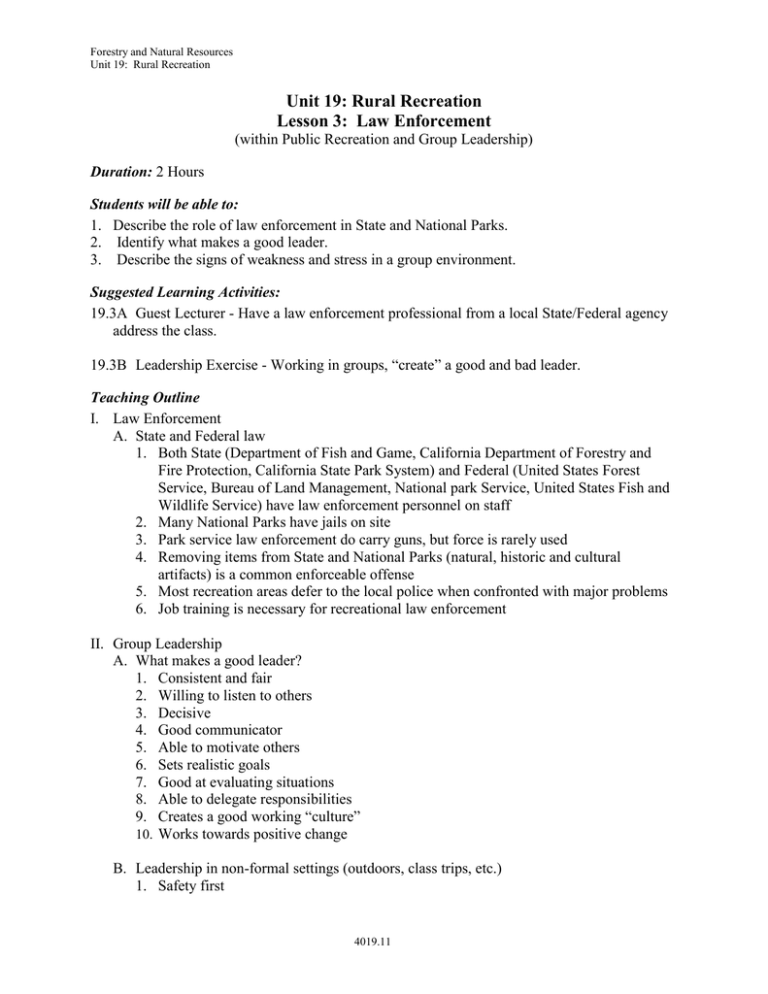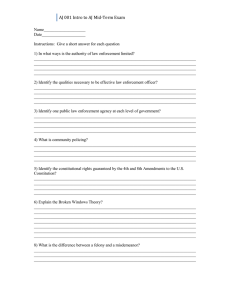Lesson 3 Law Enforcement
advertisement

Forestry and Natural Resources Unit 19: Rural Recreation Unit 19: Rural Recreation Lesson 3: Law Enforcement (within Public Recreation and Group Leadership) Duration: 2 Hours Students will be able to: 1. Describe the role of law enforcement in State and National Parks. 2. Identify what makes a good leader. 3. Describe the signs of weakness and stress in a group environment. Suggested Learning Activities: 19.3A Guest Lecturer - Have a law enforcement professional from a local State/Federal agency address the class. 19.3B Leadership Exercise - Working in groups, “create” a good and bad leader. Teaching Outline I. Law Enforcement A. State and Federal law 1. Both State (Department of Fish and Game, California Department of Forestry and Fire Protection, California State Park System) and Federal (United States Forest Service, Bureau of Land Management, National park Service, United States Fish and Wildlife Service) have law enforcement personnel on staff 2. Many National Parks have jails on site 3. Park service law enforcement do carry guns, but force is rarely used 4. Removing items from State and National Parks (natural, historic and cultural artifacts) is a common enforceable offense 5. Most recreation areas defer to the local police when confronted with major problems 6. Job training is necessary for recreational law enforcement II. Group Leadership A. What makes a good leader? 1. Consistent and fair 2. Willing to listen to others 3. Decisive 4. Good communicator 5. Able to motivate others 6. Sets realistic goals 7. Good at evaluating situations 8. Able to delegate responsibilities 9. Creates a good working “culture” 10. Works towards positive change B. Leadership in non-formal settings (outdoors, class trips, etc.) 1. Safety first 4019.11 Forestry and Natural Resources Unit 19: Rural Recreation a. Plan ahead for possible safety problems 1.) Weather 2.) Equipment failure and/or loss 3.) Injury/illness 4.) Poorly maintained facilities or equipment 2. Evaluate the group a. Know the strength and weaknesses of your group (including physical and mental) b. Watch the group for stress and/or weakness 1.) Signs of stress/weakness a.) Withdrawing from the group b.) Falling behind c.) Lack of appetite d.) Unable to sleep 2.) What causes stress a.) Over exertion b.) Fear c.) Feeling of loneliness d.) Bad attitude e.) Changes in routine (food, sleeping environment, etc.) 3.) As the leader, it’s your job to keep the group on task 3. How to evaluate/identify problems a. Closely monitor your group at all times for signs of stress b. Select a chain of command (in case something happens to you) c. Steps in problem solving 1.) Identify the problem 2.) Evaluate all the possible solutions 3.) Select a solution 4.) Implement the solution 5.) Re-evaluate the situation d. Recognize danger 1.) Canceling an activity in bad weather may not be popular, but it could save somebody’s life 2.) Make a decision before it is too late 4019.12



